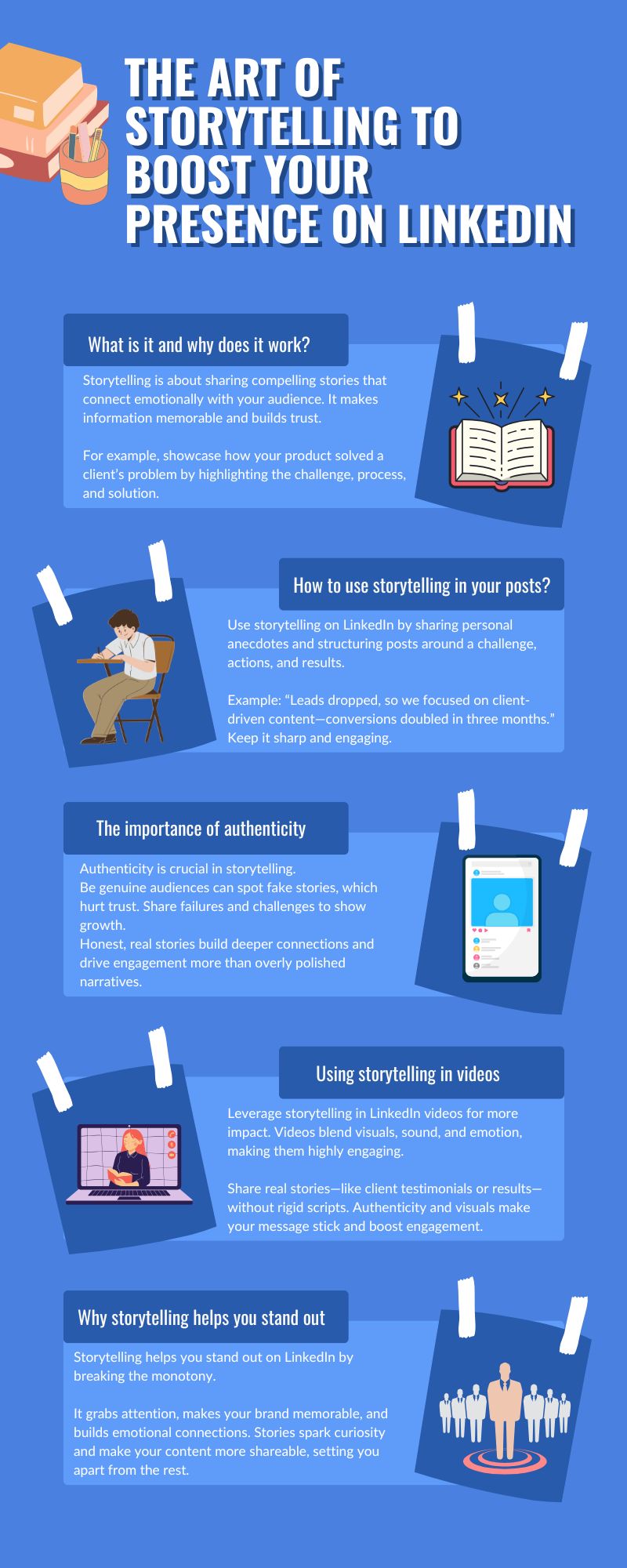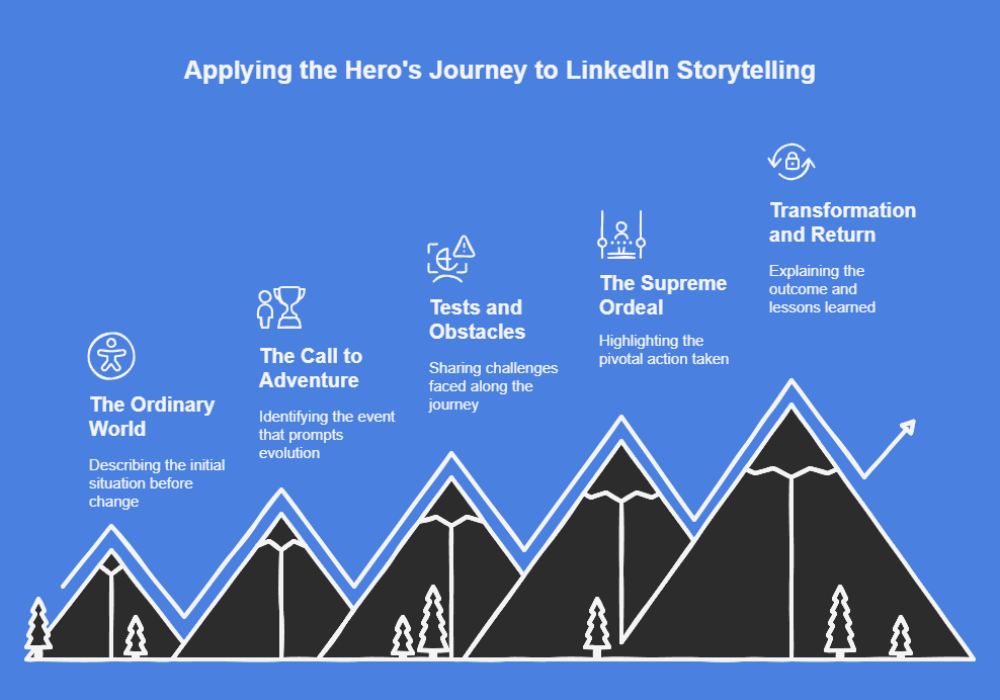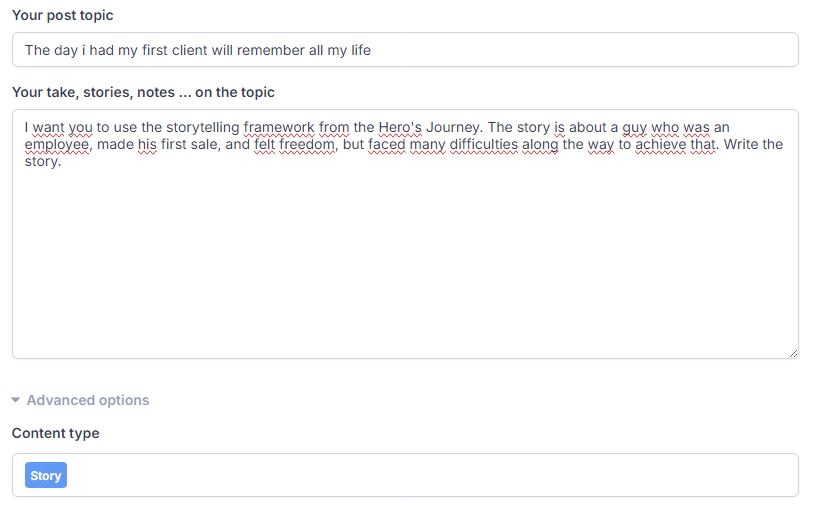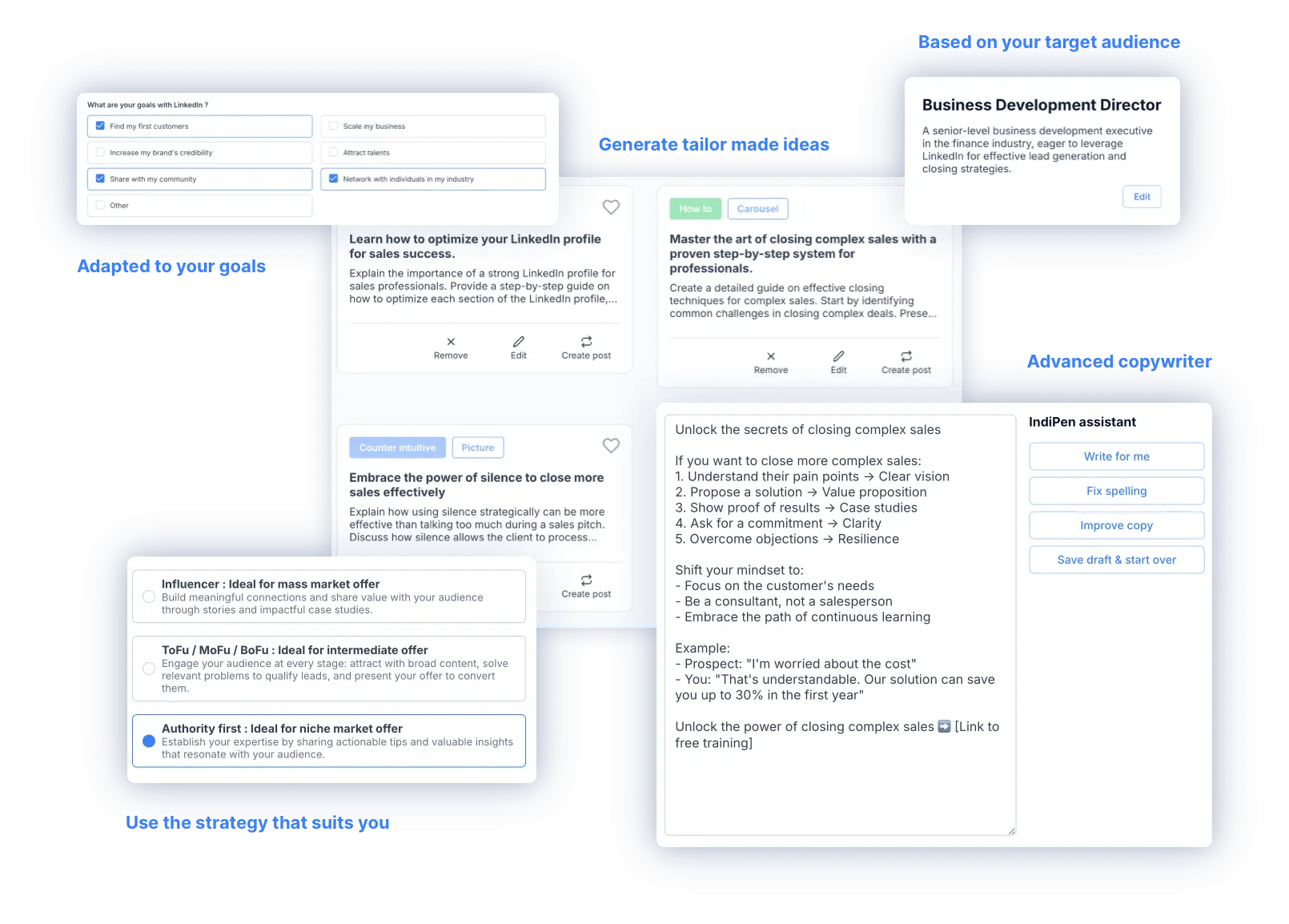How to captivate your audience with authentic stories
Why storytelling is essential on LinkedIn?
On LinkedIn, standing out in a flood of information and content requires more than just technical facts or promotional messages. To truly captivate and engage your audience, it’s crucial to tell stories. Storytelling is a powerful tool to create authentic and lasting connections.
In this article, we will explore how integrating personal narratives and proven narrative frameworks can transform your LinkedIn strategy, making your content more relevant, human, and memorable.
1. What is storytelling and why does it work?
Storytelling is about telling an engaging story that touches the emotions of your audience. Instead of limiting yourself to a factual approach, it’s about creating an emotional connection through authentic narratives.
Why does storytelling work?
- Emotional engagement: Stories trigger emotions and foster engagement.
- Memorability: People remember stories better than raw information or statistics.
- Human connection: Storytelling allows you to showcase your human side, share experiences, and build authentic relationships.
Concrete example:
Rather than just talking about your product or service, tell a story about how it helped a client solve a real problem. Describe the challenges faced, the steps taken, and the solution provided.
2. How to use storytelling in your LinkedIn posts?
Storytelling isn’t limited to long articles. It can be integrated into all your LinkedIn content, whether posts, videos, or even comments.
Some tips for using storytelling effectively:
- Share personal stories: Share personal anecdotes and professional experiences that shaped your journey. This helps you humanize yourself and show authentic sides of your personality.
- Highlight concrete successes: Illustrating success through a story helps show the real benefits of your product or service.
- Structure your story: Like any good story, it should have an introduction, development, and conclusion. For example:
- Introduction: Present the challenge or problem you or your client faced.
- Development: Show the actions taken to solve the problem.
- Conclusion: Summarize the results and lessons learned from the experience.
Example structure:
- Introduction: “Six months ago, our company faced a significant drop in leads from LinkedIn…”
- Development: “We decided to adopt a new content strategy centered around our clients’ stories…”
- Conclusion: “In just 3 months, we doubled our conversion rate and attracted the attention of new business partners.”
3. The importance of authenticity in storytelling
Storytelling on LinkedIn must be authentic and reflect who you truly are. Users can easily spot stories that are overly constructed or artificial, which can harm your credibility.
Why is authenticity crucial?
- Increased credibility: When you’re authentic, your audience sees you as reliable and sincere.
- Stronger relationships: People are drawn to authenticity. A real and honest story creates a deeper connection with your audience.
- Increased engagement: Authenticity helps your content stand out and encourages more reactions and shares.
What to do?
- Share failures or challenging moments you’ve overcome. This shows that you are human and capable of growth.
- Avoid overly embellishing your stories. Honesty trumps perfect, idealized narratives.
4. Using storytelling in LinkedIn videos
Videos are a very effective format for storytelling because they combine text, image, and sound. Integrating storytelling into your LinkedIn videos can make your messages much more impactful.
Why is video ideal for storytelling?
- Greater visual impact: Video grabs attention more easily and captures emotions.
- Easier engagement: Videos garner more engagement than regular posts, especially in terms of views, comments, and shares.
- Accessibility: Videos capture visual details that enhance the message you’re conveying.
Example of a storytelling video:
Create a video where you tell a story authentically, without an overly formal script. Use visual elements that illustrate your journey, customer testimonials, or even screenshots of results achieved.
5. Why storytelling helps you stand out on LinkedIn
Content on LinkedIn can sometimes feel repetitive or standardized. By integrating storytelling, you can differentiate yourself from the crowd and attract your audience’s attention in a unique way.
Why does this work?
- Grabbing attention: Stories create immediate interest. People want to know what happens next.
- Making your brand memorable: Telling a memorable story can make your message easier to remember.
- Creating an emotional connection: Storytelling creates an emotional connection that gives your audience a reason to return to your profile or share your content.

6. Storytelling techniques: how to build captivating stories
Narrative frameworks are powerful tools for effectively structuring your stories. Whether you’re sharing a personal journey, a professional challenge, or a success on LinkedIn, using the right structure can make your stories more engaging, memorable, and impactful. In this section, we’ll explore several well-known storytelling models to captivate your LinkedIn audience.
The hero’s journey
The hero’s journey, introduced by Joseph Campbell, is a universal narrative model that has shaped countless stories across cultures. Divided into 12 stages, each plays a crucial role in capturing the audience’s attention. On LinkedIn, applying this structure allows you to present your entrepreneurial journey in a relatable and inspiring way.
Key stages of the hero’s journey applied to LinkedIn:
- The ordinary world: Present your starting point before the major transformation (e.g., “When I started as an entrepreneur, I struggled to generate leads on LinkedIn…”).
- The call to adventure: Describe a triggering event that pushes you to evolve (e.g., “One day, I discovered that my competitors were gaining clients by posting content…”).
- Trials and obstacles: Share the challenges you faced, creating emotional resonance and authenticity (e.g., “I tested different strategies… but none worked.”).
- The supreme ordeal: The decisive moment when you took a key action (e.g., “I decided to document my journey and experiment with storytelling…”).
- Transformation and return: Explain how you overcame these challenges and the results you achieved (e.g., “In six months, I generated 10 new clients through LinkedIn. Here’s what I learned…”).

Why use this structure?
- Emotional connection: Your readers will relate to your journey.
- Sustained engagement: Suspense keeps your audience captivated until the end.
- Credibility: Sharing your evolution highlights your expertise and authenticity.
The classic narrative structure
This traditional model consists of five effective steps to tell professional experiences or projects, highlighting the challenges overcome and the solutions implemented:
- Initial situation: Present the context and characters.
- Disruptive event: An event that disrupts the initial balance.
- Developments: A series of actions and twists the protagonist faces.
- Resolution: Conflict or problem resolution.
- Final situation: Return to a new balance, different from the initial one.
Find more information on the classic narrative structure.
The actantial model
Developed by Algirdas Julien Greimas, this framework focuses on the roles of characters in a narrative:
- Subject: The main protagonist.
- Object: What the subject seeks to achieve.
- Sender: What motivates the subject to act.
- Receiver: Those who benefit from the subject’s action.
- Helpers: The subject’s aids or allies.
- Opponents: Obstacles or antagonists.
For more details on this model, check out this article on the actantial model.
The three-act structure
Commonly used in film scripts, this structure divides the story into three main acts:
- Act I - Setup: Introduction of characters and context, followed by an inciting incident.
- Act II - Confrontation: Development of conflicts and obstacles, leading to a climax.
- Act III - Resolution: The story’s conclusion and resolution.
This approach is particularly effective for structuring compelling narratives. For more details, see the three-act structure.
Freytag’s pyramid
Proposed by Gustav Freytag, this five-part structure includes:
- Exposition: Setting up the context.
- Rising action: The appearance of conflicts and complications.
- Climax: The story’s turning point.
- Falling action: Consequences of the climax.
- Denouement: Final resolution.
This model is ideal for creating progressive dramatic tension in your stories. Learn more about Freytag’s pyramid.
The loop structure
In this model, the story begins and ends similarly, illustrating the character’s or situation’s evolution. This format is particularly effective for highlighting personal learning or transformation.
How to use these structures in your LinkedIn posts?
- Choose the right structure: Depending on the message or experience you want to share, select the most relevant narrative model.
- Plan your story: Before writing, outline the key stages of your story following the chosen structure.
- Be authentic: Ensure your story reflects your voice and personal experience, even when following a predefined framework.
By applying these narrative frameworks, you will give your LinkedIn posts more coherence and impact, captivating your audience even more.
7. Practical example: how I generated a LinkedIn post using storytelling
Here’s a concrete example illustrating how the IndiPen tool was used to generate a relevant and engaging LinkedIn post. First, here’s the prompt that guided its creation.

Next, here’s the final result—a LinkedIn post that follows the platform’s best practices.
(This is a fictional example that can be manually adjusted later. Feel free to adapt it to your situation.)

This example perfectly illustrates how IndiPen turns an idea into shareable content in no time while staying relevant and engaging for the target audience.
Conclusion
Storytelling: a powerful tool to connect and engage your LinkedIn audience.
The art of storytelling isn’t just about telling a story, it’s about structuring it in a way that grabs attention and resonates emotionally. By combining proven narrative frameworks, like the three-act structure or conflict-based storytelling, with our own experiences, we create content that feels authentic and impactful.
These storytelling frameworks, refined over centuries, make narratives more fluid and coherent, improving both understanding and impact. They help bring meaning to the events we share and guide the audience through an emotional journey from start to finish. When we integrate our personal experiences, challenges, failures, and successes, we build a human connection, making our message more relatable and engaging.
Instead of just presenting facts or ideas, storytelling transforms our message into a compelling narrative that captures attention, sparks interest, and strengthens audience engagement. On LinkedIn, this kind of content is a powerful communication asset, it helps stand out and deliver real value to our network.
By skillfully blending narrative structure with personal storytelling, each post becomes an opportunity to share a strong message and build deeper relationships with our audience. It’s not just about selling an idea or a product, it’s about telling a story that leaves a lasting impression and drives engagement.
Ready to turn your LinkedIn profile into a Lead Machine ?
IndiPen helps you define your strategy, find content idea and write engaging content to generate leads with ease
Book a demo
